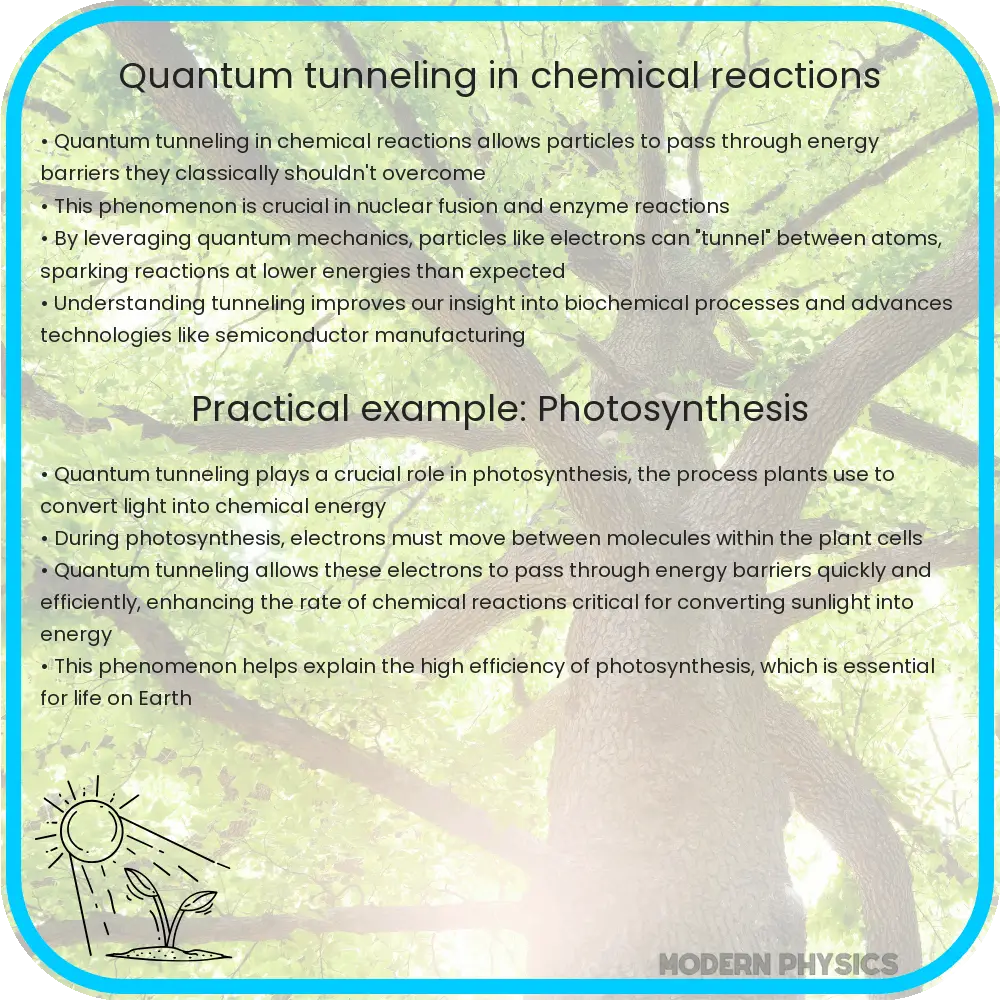Quantum tunneling is a quantum mechanical phenomenon where particles pass through barriers they classically should not, influencing various scientific processes.

Understanding Quantum Tunneling: Fundamentals and Impact on Reaction Dynamics
Quantum tunneling is a fascinating quantum mechanical phenomenon where a particle passes through a potential energy barrier that it classically shouldn’t be able to surmount. This ability of particles to ‘tunnel’ through barriers plays a critical role in various physical, chemical, and even biological processes. Grasping the concept of quantum tunneling can offer profound insights into the behavior of electrons in atoms, nuclear fusion in stars, and even the mutations in our DNA.
The Basics of Quantum Tunneling
At its core, quantum tunneling defies the classical understanding of physics. In classical mechanics, a particle with energy less than the height of a potential barrier would be reflected. However, quantum mechanics introduces the concept of wave-particle duality, where particles exhibit properties of both particles and waves. The wave function, which describes the probable location of a particle, can extend beyond a barrier, even if the particle’s energy is too low to overcome the barrier classically.
When a particle approaches a barrier, the wave function of the particle does not stop abruptly at the barrier but slightly penetrates it, decreasing exponentially within the barrier. This penetration enables a non-zero probability that the particle will appear on the other side of the barrier, effectively ‘tunneling’ through it.
Quantifying Tunneling: The Tunneling Probability
The likelihood of a particle tunneling through a barrier depends on several factors, key among them being the width and height of the barrier, and the mass and energy of the particle. Mathematically, the tunneling probability (T) can be estimated using a simplified model such as:
- The barrier width (d)
- The height of the barrier (V0) relative to the energy of the particle (E)
A common approximation of the tunneling probability is given by:
\[ T \approx e^{-2 \gamma d} \]
where
\[ \gamma = \frac{\sqrt{2m(V_0 – E)}}{\hbar} \]
In this equation, \( \gamma \) is known as the decay constant which describes how quickly the wave function decreases inside the barrier, \( m \) is the mass of the particle, \( V_0 \) is the potential energy inside the barrier, \( E \) is the energy of the particle, and \( \hbar \) (h-bar) is the reduced Planck’s constant.
Enhancing the Rate of Tunneling
The rate of tunneling can be influenced by manipulating the conditions outlined earlier. Adjusting either the energy of the particle, the width, or the height of the barrier can significantly affect the probability of tunneling:
- Decreasing the barrier width: A narrower barrier means a shorter distance for the wave function to decay, therefore, enhancing the tunneling probability.
- Increasing the particle’s energy: When the energy of the particle approaches the barrier’s potential energy, the decay constant (\( \gamma \)) decreases, thereby increasing the likelihood of tunneling.
- Lowering the barrier height: Decreasing \( V_0 \) while keeping the particle’s energy constant also makes tunneling more probable as the difference \( V_0 – E \) becomes smaller.
Each of these modifications has the potential to significantly alter the dynamics of a reaction or system by enhancing the rate at which quantum tunneling occurs.
Quantum Tunneling in Chemical Reactions
In chemical reactions, quantum tunneling can explain why some reactions occur at rates much faster than predicted by classical models. The transfer of protons, for example, is central to many biological and chemical processes and can often proceed via tunneling, thereby circumventing traditional reaction barriers. This introduces an important variable in the study of reaction dynamics and the exploration of new chemical pathways.
Applications in Technology and Medicine
Quantum tunneling is not just a theoretical concept but has practical applications in various technological fields. In modern electronics, tunneling is the principle behind the operation of devices such as tunnel diodes and quantum dot transistors. These components are crucial for developing high-speed, low-power consuming electronics. Additionally, the scanning tunneling microscope (STM), which relies on tunneling to image surfaces at the atomic level, has been instrumental in advancing nanotechnology.
In the field of medicine, quantum tunneling principles are beginning to influence the design of drugs and the understanding of enzyme reactions. By exploiting the tunneling of electrons or protons in biological molecules, researchers can design more effective pharmaceuticals with better efficacy and lower side effects.
Future Prospects and Challenges
The study of quantum tunneling continues to open new frontiers in physics and chemistry. With every advance in measuring and manipulating quantum systems, scientists uncover more about the fundamental processes that govern our universe. However, there remain substantial challenges. The complexities of quantum systems make them difficult to study, and achieving precise control over these systems is an ongoing research pursuit.
Moreover, integrating quantum tunneling into everyday technology presents practical challenges due to issues like decoherence and the need for extremely low temperatures in some quantum applications. Overcoming these hurdles requires innovative approaches and further technological breakthroughs.
Conclusion
Quantum tunneling, a phenomenon where particles defy classical mechanics by passing through potential barriers, has profound implications across science and technology. From explaining astrophysical phenomena and biological mutations to enabling the development of cutting-edge technologies and drugs, its influence is extensive. As we continue to explore and understand quantum tunneling, its integration into new technologies and systems holds promising potential for future innovations. The ongoing challenge lies in harnessing this quantum behavior in practical applications, a goal that continues to drive much of current research in quantum physics and engineering.
Thus, while quantum tunneling may appear esoteric, its impacts are far-reaching, affecting everything from the microcosmic particles in our cells to the broad advancement of technology and medicine. As research progresses, the boundaries of what can be achieved through the understanding and application of quantum tunneling continue to expand, heralding an era of scientific discovery and technological innovation like never before.
